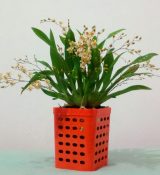Growing Orchids Indoors
Author: admin12 Comments
Growing Orchid Plants Indoors Overview by Orchidplantcare.info
Orchid plants have become increasingly popular and are now common in many garden stores and nurseries. If you want the plant to continue growing after bloom, and bloom again in future years, choosing the right one is key. Another important orchid growing factor is the culture, which is a bit different from most other indoor plants.
To begin with, orchids vary in their temperature requirements. Choose those that fit your home environment in winter, warm-growing ones if it is consistently warm (68-75 degrees) or intermediate-growing if night temperatures are lower (60-65 degrees). It is very important for orchids of all types is high humidity and high light during winter, indirect light during summer.
If you buy an orchid, you may notice it is not growing in soil but rather in bark, a black fiber (roots from the osmunda fern), or similar material. This is because most orchids are “epiphytic,” getting most their water and nutrients from the air through aerial roots. These are often the white thick roots you see growing from the plant on the surface or even outside the pot, which should NEVER be cut off. Exceptions to the epiphytes are the few that grow in soil (terrestrial) or on rocks (lithophytic).
Many epiphytes have upright swollen stems called “pseudobulbs” which rise from a rooted horizontal stem. They serve to store food and water. Examples of these are popular genera such as Cattleya, Dendrobium, Epidendrum, Laelia, and Oncidium. New pseudobulbs are formed along the horizontal stem, meaning growing is in a horizontal direction. Such orchids are often called “sympodial”. If these are planted in osmunda, you may need to water every 3 or 4 days. Water more often if they are planted in bark.
Other epiphytes, such as Vanda and Phalaenopsis, don’t have pseudobulbs. Their growth is upright along a single stem. Aerial roots come from the stem, often from between the leaves. These orchids are often called “monopodial”. Since they don’t have storage structures either above or below ground, they often need water daily.
When checking for water, never let the orchids dry out completely. Water well until water is running out the bottom of the pot. But don’t let plants stand in water, as in a saucer. I find it easier to water pots holding them over a sink or bucket.
Epiphytic orchids are quite sensitive to air pollution, water quality, and too much fertilizer. If too little fertilizer, pseudobulbs may shrivel and leaves turn light green or yellow. If leaves are dark green and floppy, and there are no flowers, this indicates too much fertilizer. Blackened root tips indicates damage from too much fertilizer.
Softened water should not be used, as the salts will damage roots. Most chlorinated city water sources can be used, although excess chlorine can also damage roots. The best water to use is distilled water, pure spring water as you often find in stores, or even collected rain water.
Fertilizer varies mostly with type of growing medium, type of and amount of growth. Plants actively growing, sending out new shoots, will need fertilizer. If inactive or dormant, as in the rest period with some orchids, don’t fertilize.
Plants growing in osmunda need less fertilizer than those growing in bark. Sympodial orchids, having the pseudobulb storage organs, need less fertilizer than monopodial ones. Although most houseplant fertilizers will work, you may wish to get one specially formulated for orchids. Follow label directions for the rate. A general houseplant fertilizer, applied to plants in bloom or active growth, might be every two weeks for sympodial orchids in bark, every 4 weeks if in osmunda, and twice as often for monopodial orchids.
12 Responses to “Growing Orchids Indoors”
Leave a Reply


Ask an Expert
Questions about orchids?
Our experts love a challenge!
Photo of the Week
Submit your photo to be featured on the blog!
More Photo of the Week Winners
Submit Photo








I have a Phalaenopsis. It was doing great but the flowers have all fallen off within the last week and a half. A new leaf (or something) is growing out of the soil. Has this used up all the nutrients and left none for the flowers? What do I do with it to get more flowers? Do I cut off the stem they were on?
Many orchids can bloom 2 or 3 times per year. In order to initiate the flower spikes, it is important to grow the plant in an area where the night temperatures fall below 65°. It sounds like you’re describing a new spike. Read our ‘Blooming Orchids’ archive for more detailed information. Good luck!
I have a purple and white orchid I think it is a single stem orchid. It has a snake like mouth and i just need to know if it is dead or if i should eep it and see if it grows back.
I have just purchased a Phal,growing in sphagnim moss.Can I carefully repot it into a bark mixture now or should I wait till it stops flowering?
My orchids leaves are turning a yellow and i do everything that is needed. What am I doing wrong?
I recently bought an orchid from our local grocery store. It’s white and grows horizontal. The instructions say to water once a month but not allow the root to sit in water. I have followed the directions, however, the white flowers are getting brown dots on them. What am I doing wrong?
I have seen orchids growing with no soil. This is how they do them in Spain. They are beautiful grown this way. The orchid is secured to the top of the glass vase and their roots grow below into the vase with no soil. They seem to thrive this way, is this recommended?
My orchid has lost all it’s bloom…should I cut back the stem…how can I get it to bloom again?
I dont know what kind I have. Im a “new” gardener I have always LOVED plants ans ESP lillys and orchids.*anyway* It grows uppward it is in a little pot like the size you would give your kids to drink out of, it has beautifull flowers on it, green leaves, but I want to make sure it reproduces and keeps growing. How do I do that.
I have a single stem orchid plant. There is a new green leaf growing but the actual orchid stem is brown (looks dead). Is the plant dead or can it be saved and how?
My orchid’s flowers are falling off don’t know what to do now if I should cut it back or leave it will it bloom again I live in Ontario Canada I hope you can help it is such a beautiful plant thank
kim ward
I like it bring in the red roses in Orchid. Plant Care.